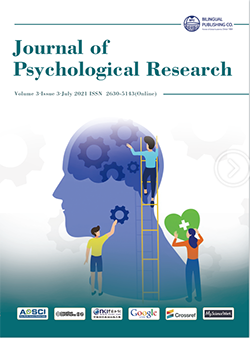-
1533
-
1339
-
1324
-
1323
-
1200
Animal Assisted Therapy: It’s Implications among Disorders, for Therapeutic Practice, and in Health and Well-being
DOI:
https://doi.org/10.30564/jpr.v3i3.3181Abstract
Till the time one has not loved an animal, a part of one’s soul remains unborn. Animal Assisted Therapy can be used in amalgamation with other forms of therapy. The animal becomes an assimilation of the therapeutic plan with AAT. Many psychological disorders have been shown to react well to Animal-Assisted Therapy (AAT). The article is a concise literature review on Animal Assisted Therapy of database available from the studies that were integrated and provided a general understanding of the perceived benefits of Animal Assisted Therapy and includes topics that are categorised as an Introduction to Animal Assisted Therapy: how it can help people with disorders, it’s utilisation in therapeutic practice and its relation to our health and well-being. Papers were considered eligible if they satisfied the following pre-determined criteria: (1) Talked about Animal Assisted Therapy in context to well-being of an individual, (2) Talked about implications of Animal Assisted Therapy in context to disorders and (3) Showed benefits of Animal Assisted Therapy in counselling. This paper further provides an overall review of Animal Assisted Therapy. Relevant data was summarized and collated to make a narrative account of the findings that animal in the therapy would not make it more difficult, but rather make it easier, the therapist be aware of any animal-related allergies when employing animals as adjuncts and animals can help have a better emotional and physical healing experience by the patient
Keywords:
Animal Assisted Therapy, Well Being, Therapeutic Practice, Health, DisordersReferences
[1] Arnold, J.C. (1995). Therapy dogs and the dissociative patient: preliminary observations. Dissociation, 8 ,247-252.
[2] Barak, Y., Savorai, O., Mavashev, S., & Beni, A. (2001). Animal-assisted therapy for elderly schizophrenic patients: a one-year controlled study. American Association for Geriatric Psychiatry, 9(4), 439- 442.
[3] Barker, S. B., & Dawson, K. S. (1998). The Effects of Animal-Assisted Therapy on Anxiety Ratingsof Hospitalized Psychiatric Patients. Psychiatric Services, 49(6), 797-801. https://doi.org/10.1176/ps.49.6.797.
[4] Beck, A., Hunter, K., & Seraydarian, L. (1986). Use of animals in the rehabilitation of psychiatric inpatients. Psychological Reports, 58, 63-66.
[5] Brodie, S., Biley, F. C., & Shewring, M. (2002). An exploration of the potential risks associated with using pet therapy in healthcare settings. Journal of Clinical Nursing, 11, 444-456.
[6] Chandler, C. K. (2017). Animal-Assisted Therapy in Counseling (3rd ed.). Routledge.
[7] Evans, N., & Gray, C. (2012). The practice and ethics of animal-assisted therapy with children and young people: is it enough that we don’t eat our co-workers? Br J Soc Work, 42(4):600-17.
[8] Fine, A. H. (2010). Incorporating animal-assisted therapy into psychotherapy. Handbook on Animal-Assisted Therapy, 169-191. DOI: https://doi.org/10.1016/b978-0-12-381453-1.10010-8.
[9] Gayathri, B., & Priscilla, P. (2018). On implementation of animal-assisted therapy (AAT) in a school for children with special needs-Indian Journals. Indian Journals, 8(11),182-193.
[10] Hoffmann, A. O. M., Lee, A. H., Wertenauer, F., Ricken, R., Jansen, J. J., Gallinat, J., & Lang, U. E. (2009). Dog-assisted intervention significantly reduces anxiety in hospitalized patients with major depression. European Journal of Integrative Medicine, 1(3), 145-148. DOI: https://doi.org/10.1016/j.eujim.2009.08.002.
[11] Jorgenson, J. (1997). Therapeutic Use of Companion Animals in Health Care. Image: The Journal of Nursing Scholarship, 29(3), 249-254.DOI: https://doi.org/10.1111/j.1547-5069.1997.tb00993.x.
[12] Kruger, K., Trachtenberg, S., & Serpell, J. A. (2004). Can animals help humans heal? Animal assisted interventions in adolescent mental health. Retrieved from. http://www2.vet. upenn.edu/research/centres/cias/pdf/CIAS_AAI_white_paper.pdf.
[13] Macauley, B. (2006). Animal-assisted therapy for persons with aphasia: A pilot study. Journal of rehabilitation research and development, 43, 357-66.
[14] Martin, F., & Farnum, J. (2002). Animal-Assisted Therapy for Children with Pervasive Developmental Disorders. Western Journal of Nursing Research, 24(6), 657-670. DOI:https://doi.org/10.1177/019394502320555403.
[15] Nazarian, Z., Armoon, B., Rezaei, O., Banihashem, S., & Hamideh M. (2018). The effect of pet therapy concurrent with common medication on positive, negative, cognitive and motor symptoms of schizophrenia: a randomized control trial. Pol Psychol Bull, 49(2):200-6.
[16] Odendaal, J. S. J. (2000). Animal-assisted therapy — magic or medicine? Journal of Psychosomatic Research, 49(4), 275-280. DOI: https://doi.org/10.1016/s0022-3999(00)00183-5.
[17] Odendaal, S. J., & Meintjes, R. (2003). Neurophysiological correlates of affiliative behavior between humans and dogs. Veterinary Journal, 165, 296-301.
[18] Palley, L. S., O’Rourke, P. P., & Niemi, S. M. (2010). Mainstreaming Animal-Assisted Therapy. ILAR Journal, 51(3), 199-207. DOI: https://doi.org/10.1093/ilar.51.3.199.
[19] Peacock, C. (1986). The role of the therapeutic pet in initial psychotherapy sessions with adolescents. Boston: Paper presented to Delta Society International Conference.
[20] Richeson, N. E. (2003). Effects of animal-assisted therapy on agitated behaviors and social interactions of older adults with dementia. American Journal of Alzheimer’s Disease & Other Dementias, 18(6), 353- 358. DOI: https://doi.org/10.1177/153331750301800610.
[21] Roenke, L., & Mulligan, S. (1998). The Therapeutic Value of the Human-Animal Connection. Occupational Therapy in Health Care, 11(2), 27-43. DOI: https://doi.org/10.1080/j003v11n02_03.
[22] Walsh, P. G., Mertin, P. G., Verlander, D. F., & Pollard, C. F. (2010). The effects of a ‘pets as therapy’ dog on persons with dementia in a psychiatric ward. Australian Occupational Therapy Journal, 42(4), 161-166. DOI: https://doi.org/10.1111/j.1440-1630.1995.tb01331.x.
[23] Wilson, C. C., & Turner, D. C. (1997). Companion Animals in Human Health (Discoveries) (1st ed.). SAGE Publications, Inc.
[24] Voelker, R. (1995). Puppy Love Can Be Therapeutic, Too. JAMA: The Journal of the American Medical Association, 274(24), 1897. DOI: https://doi.org/10.1001/jama.1995.03530240007002.
Downloads
How to Cite
Issue
Article Type
License
Copyright © 2021 Shireen Dargan

This is an open access article under the Creative Commons Attribution-NonCommercial 4.0 International (CC BY-NC 4.0) License.




 Shireen Dargan
Shireen Dargan





